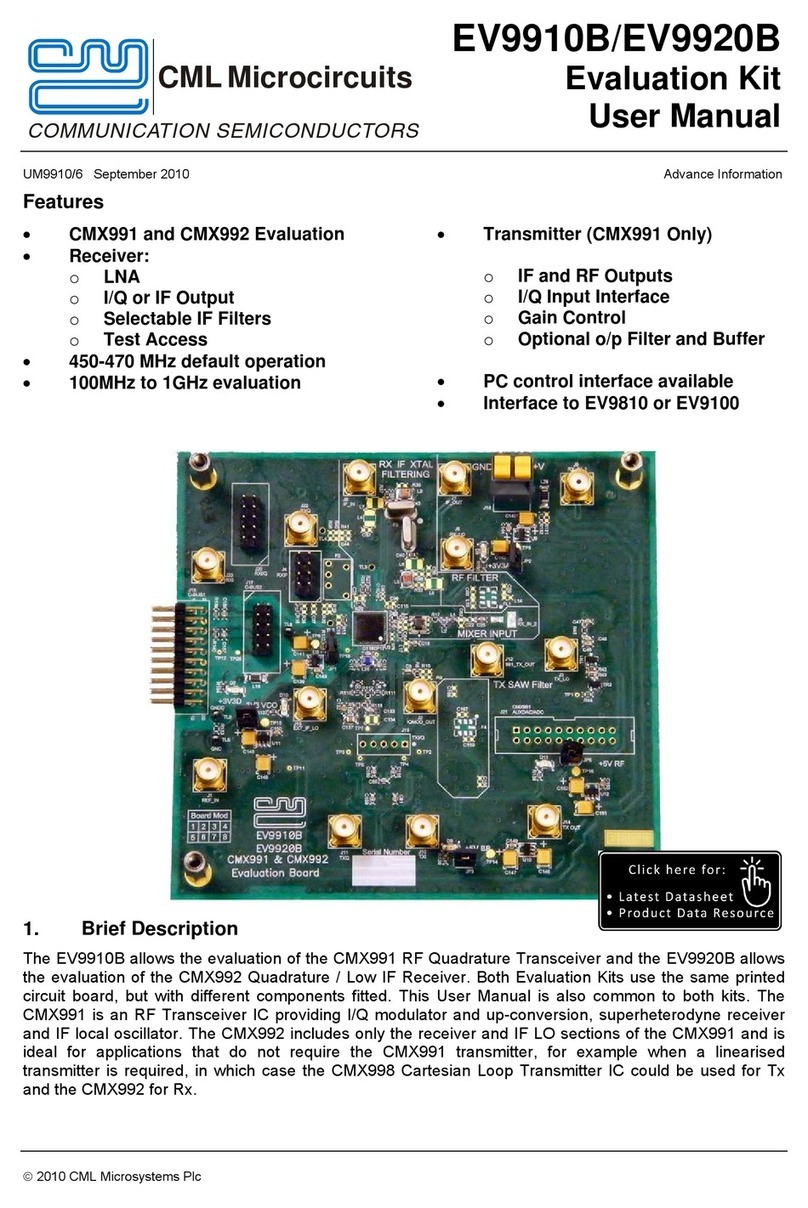
Application Note CMX7031: An Example Core Design for a Complete Family Radio
© 2007 CML Microsystems PLC 6 of 28 AN/2WR/7031/FRS/3 July 2007
3.3 Assumptions
The following assumptions were used in the development of this application note:
VDD = 3.3V provided by three “AAA” batteries (3 cells x 1.5V / cell = 4.5V nominal).
o Low dropout regulator used to step down battery voltage for CMX7031.
o “Low Battery Warning” at 3.6V (arbitrarily chosen).
o Battery voltage scaled (60% reduction) prior to presentation to CMX7031 AUXADC4
input pin.
FRS service with 25kHz channel spacing.
External components configured in accordance with CMX7031 datasheet.
19.2MHz TCXO supplies signals to both XTAL / CLK pin and RF CLOCK input (common to
both synthesizers). Baseband and RF clocks are derived from this 19.2MHz TCXO input.
System Clock Generators
o Clock Output 1 = 12.288MHz
o Clock Output 2 = 16.384MHz
Single point modulation used.
Voice and CTCSS subaudio tone transmitted on MOD1.
o Voice + CTCSS output level = 500mVRMS
Voice = 455mVRMS
CTCSS = 45mVRMS
o Note: Actual voice and subaudio tone levels depend on VCO sensitivity and desired deviation; these
specifications are application dependent. A discussion of CMX7031 maximum signal levels is presented
later in the document.
Voice:
o Preemphasis and deemphasis enabled
o Companding enabled
o Soft Limiter threshold = 525mVRMS
Subaudio Tones:
o CTCSS subaudio tone is used during voice transmissions for squelch control.
Tone # 20 (131.8Hz) generated during voice transmission.
Tone # 1 (67.0Hz) detected during voice reception.
o No subaudio inversion.
FFSK / MSK:
o Transmitted on MOD1 (no subaudio tone used for FFSK / MSK transmissions).
MOD1 output level = 500mVRMS
o FFSK / MSK Address = 79 (arbitrarily chosen).
o 2400 bps, Type 5 message format.
o Frame length = 80 bytes (arbitrarily chosen).
o Standard scrambling seed.
o Default bit sync (0x5555) and frame sync (0xCB23) patterns are used
Ring Tone
o 1250Hz ring tone is used in this scenario but the user can select different ring tones
or combinations of tones.
o Ring tone level = 500mVRMS
RSSI signal monitored with ADC1 via AUXADC1 pin during sleep and Rx modes.
o High threshold (good carrier signal) = 1.85V for –60dBm received signal strength.
o Low threshold (indicates weak signal) = 0.9V for –100dBm received signal strength.
Note: The received signal strength values used for this document include no “noise margin”. The user
must evaluate their application and determine the optimal RSSI threshold and hysteresis settings.
RF discriminator output is applied to CMX7031 DISC pin.
CMX7031 AUDIOOUT pin delivers ring / alerting tones and recovered voice to an external
speaker driver amplifier for presentation to the radio speaker.
RF Synthesizer
o FRS Channel 1 = 462.5625MHz, used for Tx and Rx.
o CMX7031 Channel 1 Synthesizer used for Tx RF upconversion.
o CMX7031 Channel 2 Synthesizer used for Rx downconversion.




























